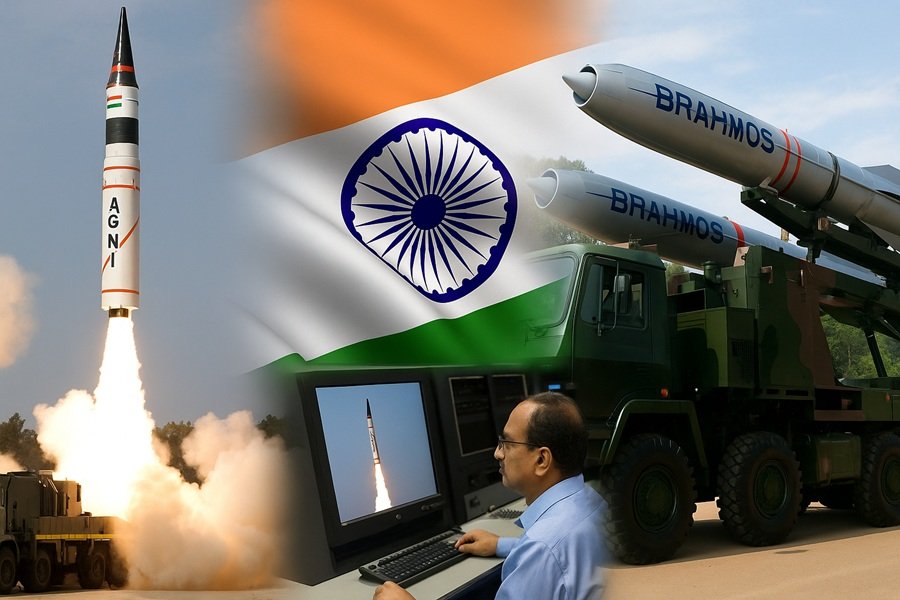
Introduction: India’s Evolving Missile Power
India’s missile program has grown from modest beginnings in the 1980s to a sophisticated arsenal that spans short-range tactical missiles to intercontinental ballistic missiles (ICBMs) capable of delivering nuclear payloads. Spearheaded by the Defence Research and Development Organisation (DRDO) and bolstered by international collaborations, India’s missile capability underpins its strategic deterrence, regional power projection, and national security doctrine.
India follows a “No First Use” (NFU) nuclear policy, but its credible minimum deterrence is built upon a diverse missile portfolio capable of responding to threats from adversaries like Pakistan and China.
Categories of Indian Missiles
India’s missile arsenal can be classified into:
- Ballistic Missiles
- Cruise Missiles
- Anti-tank Missiles
- Surface-to-Air Missiles (SAM)
- Hypersonic Missiles (in development)
Let’s explore each category in detail.
Read This: Best Air-to-Air Missiles in the World: Top 10 AAMs for Modern Combat
Ballistic Missiles: Backbone of Nuclear Deterrence
Agni Series
The Agni series forms the core of India’s nuclear delivery systems.
| Missile | Type | Range (km) | Payload | Status |
|---|---|---|---|---|
| Agni-I | SRBM | 700–1,200 | Conventional/Nuclear | Operational |
| Agni-II | MRBM | 2,000–3,500 | Nuclear | Operational |
| Agni-III | IRBM | 3,000–5,000 | Nuclear | Operational |
| Agni-IV | IRBM | 4,000+ | Nuclear | Operational |
| Agni-V | ICBM | 5,000–8,000 | Nuclear | Operational |
| Agni-P (Prime) | MRBM | 1,000–2,000 | Conventional/Nuclear | Under testing |
Agni-V is the crown jewel of the arsenal, capable of reaching almost all of China and parts of Europe. It employs canister-based launch technology, enhancing mobility and response time.
Prithvi Series
These were India’s first indigenously developed ballistic missiles.
| Missile | Type | Range (km) | Payload | Status |
|---|---|---|---|---|
| Prithvi-I | SRBM | 150 | 1,000 kg | Army use |
| Prithvi-II | SRBM | 250–350 | 500–1,000 kg | Air Force use |
| Prithvi-III (Dhanush) | Naval variant | 350 | 500–1,000 kg | Navy use |
Cruise Missiles: Precision Strikes at Long Ranges
BrahMos: The Supersonic Game-Changer
The BrahMos missile is a joint Indo-Russian project, combining speed, accuracy, and versatility.
| Variant | Range (km) | Speed | Platform |
|---|---|---|---|
| BrahMos Block-I/II | 300–450 | Mach 2.8–3.0 | Land/Sea |
| BrahMos-A | ~400 | Mach 3 | Air (Su-30MKI) |
| BrahMos-NG (upcoming) | 290 | Mach 3.5 | Compact platform |
- Uses: Anti-ship, land-attack
- Known for: Precision, supersonic speed, low radar cross-section
BrahMos-II, a hypersonic version (Mach 7+), is under development and expected to redefine cruise missile warfare.
Read This: BrahMos vs BrahMos-II
Nirbhay: Subsonic Stealth Missile
- Range: 1,000+ km
- Speed: Mach 0.7
- Guidance: Inertial + GPS + Terrain Contour Matching (TERCOM)
- Status: Under development/testing
Nirbhay is designed for deep-strike missions with terrain-hugging ability, akin to the American Tomahawk.
Surface-to-Air Missiles (SAMs): Shielding the Skies
Akash Missile System
- Type: Medium-range SAM
- Range: 25–30 km
- Altitude: Up to 18 km
- Warhead: 60 kg fragmentation
Used by the Indian Army and Air Force to defend against aircraft and drones. Upgraded versions like Akash-NG promise extended range and better interception.
Other Notable SAMs:
| Missile | Range | Use |
|---|---|---|
| QRSAM (Quick Reaction SAM) | 25–30 km | Fast-moving targets |
| VL-SRSAM (Naval) | ~40 km | Ship-borne air defense |
| MR-SAM/Barak 8 (Jointly with Israel) | 70–100 km | Long-range air defense |
| XRSAM (Under development) | 250–350 km | Advanced threat interception |
India is also a buyer of S-400 Triumf systems from Russia — long-range SAM systems (up to 400 km) capable of intercepting cruise missiles, aircraft, and ballistic missiles.
Anti-Tank Guided Missiles (ATGMs)
India’s indigenous ATGMs have seen major strides in recent years.
Notable Indian ATGMs:
| Name | Type | Guidance | Range |
|---|---|---|---|
| Nag | Fire-and-forget | Imaging IR | 4–7 km |
| Helina (Helicopter-launched Nag) | Fire-and-forget | Imaging IR | 7–10 km |
| MPATGM (Man-Portable) | Fire-and-forget | Imaging IR | ~2.5 km |
| SANT (Stand-off ATGM) | Lock-on after launch | 15–20 km |
Nag and its derivatives are crucial to Indian Army’s plans to reduce dependence on imported anti-tank systems.
Hypersonic Missiles: The Future Frontier
Hypersonic Technology Demonstrator Vehicle (HSTDV)
India successfully tested the HSTDV in 2020, marking progress in developing a hypersonic cruise missile. The goal is a scramjet-powered missile reaching Mach 6–7, potentially forming the basis of BrahMos-II.
India is among only a handful of nations — the US, Russia, and China — advancing in hypersonic weapons.
Strategic Missile Forces: Triad-Ready
India has operationalized its nuclear triad, meaning the ability to launch nuclear weapons from:
- Land (Agni series)
- Sea (SLBMs like K-15, K-4 on INS Arihant-class submarines)
- Air (Modified aircraft like Mirage-2000, Su-30MKI)
Submarine-Launched Ballistic Missiles (SLBMs):
| Missile | Range | Platform |
|---|---|---|
| K-15 (Sagarika) | ~750 km | INS Arihant |
| K-4 | ~3,500 km | INS Arighat (under trials) |
These SLBMs ensure second-strike capability, crucial to India’s strategic deterrent posture.
Indigenous Development and Strategic Autonomy
India’s missile capabilities have largely been indigenized under programs like:
- Integrated Guided Missile Development Programme (IGMDP) launched by Dr. A.P.J. Abdul Kalam in the 1980s.
- Modern DRDO initiatives under Make in India and Aatmanirbhar Bharat.
Despite initial restrictions like the Missile Technology Control Regime (MTCR), India has emerged as a missile-exporting nation with partners in Southeast Asia, Africa, and the Middle East.
Challenges and the Road Ahead
Challenges:
- Precision guidance in electronic warfare environments
- Satellite-based targeting integration
- Real-time command and control systems
- Counter-drone capabilities
Upcoming Projects:
- BrahMos-II (hypersonic)
- Agni-VI (ICBM with MIRV potential)
- Smart Anti-Airfield Weapon (SAAW)
- Long-Range Glide Bombs
- AI-driven missile targeting and swarm capabilities
Conclusion: India’s Missile Arsenal and Regional Stability
India’s missile arsenal represents more than just firepower — it is a symbol of technological advancement, strategic depth, and national resilience. From Agni to BrahMos, and Nag to Nirbhay, India’s missiles provide credible deterrence and regional stability in a volatile geopolitical neighborhood.
As India advances toward hypersonic weapons, MIRVs, and space-based sensors, its missile program is poised to become a global benchmark in 21st-century defense technology.







